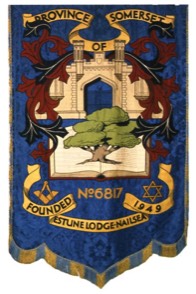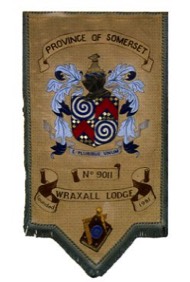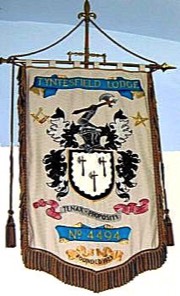The Formation of the Lodge.
In 1946 the inhabitants of this country, who for a period of six years had been subjected to an almost intolerable burden of stress, and at times calamity, were endeavouring to return to some normality. Many, each in his own way, sought a haven or a refuge in which life could be rebuilt and those moral values, which had become so eroded, regained and strengthened. It was under such conditions that requests for admission into our order rose at an abnormal rate. This was not the first time such had occurred. It was first noticed early in the 1800s after the Napoleonic Wars and again early in the 1920s following the First World War. Tyntesfield Lodge owes much of its existence to these circumstances.
Another factor was that Tyntesfield Lodge which had, since its formation, initiated, passed and raised its candidates in pairs, had decided, for obvious reasons, that this practice should cease and candidates would be dealt with singly. This decision halved the rate of acceptance into this lodge and put a heavy strain on the already long list of candidates waiting. Means had to be sought to ease the strain on the waiting candidates. Therefore to prevent applicants from waiting for several years it was decided that they should be given the opportunity of seeking admission elsewhere.
Long Ashton, a village of antiquity and almost wholly residential, was at this time expanding rapidly. Among many of the inhabitants were members of our Fraternity, some of whom belong to Tyntesfield Lodge. Foremost among those not members of Tyntesfield were W.Bro John Randell of Rural Philanthropic Lodge at Burnham, W.Bro M.C. O’Connor of Bengal, Bro Ladbrook Hurley, Bro Robert Brown, Bro A.E. Morrish and others.
The Long Ashton residents who were members of Tyntesfield were W.Bro H.E. Horler, Bros W.D. and A.V. Mereweather, Bro H. Patch and Bro R.L. Singer. These Brethren, realising the need and also the desire for a new Lodge, which would be representative of the members of our order living in Long Ashton, decided to call a meeting of those interested.
With this in mind they invited W.Bro W.J. Mullings the Secretary, W.Bro G. Foster and Bro T.A. Gane, all of Tyntesfield, to consider the formation of a new Lodge.
The stage was set. There followed twelve pre-formative, or pre-natal, meetings commencing on 12th March 1948. On October 5th 1948 there occurred a most important event in the history of the Lodge, when, in Tyntesfield Lodge, upon a proposition by W.Bro W.J.Mullings, seconded by Bro W.D. Mereweather, it was unanimously agreed that a petition be forwarded to Grand Lodge, through Provincial Grand Lodge, that a warrant be granted to form a Daughter Lodge to be named Estune Lodge, which was the ancient name for Long Ashton. The name Estune was taken from the Doomsday book and probably indicates a community living to the west of the river and city of Bristol. Today’s modern name for the combined original villages of Estune and Yanley is Long Ashton.
The Lodge was to meet at the Nailsea Masonic Hall, Nailsea Park, this being the nearest and most suitable venue at the time within the Province of Somerset. After following the proper procedure and channels the Warrant was granted and Estune Lodge No 6817 was registered. It was proposed that the Lodge should meet nine times a year from September through to and including May, on the third Tuesday in the month. The May meeting was eventually dropped, largely because of attendance, the last one being in May 1980, although re-established for the Golden anniversary celebration in May 1999.
The Consecration Ceremony was held on Thursday 19th May 1949, after a pre meeting luncheon held in the Battle Axes Hotel, Wraxall. The ceremony was led by the R.W. Provincial Grand Master for Somerset, Brigadier General Claude Lumsden Norman, assisted by:
W.Bro F.E. Nutt PJGD Eng, Deputy Provincial Grand Master. W.Bro A.E. Beavis, Provincial Senior Grand Warden. W.Bro F.J. Williams, Provincial Junior Grand Warden. W.Bro J.E. Pugh, Provincial Pro Grand Chaplain. W.Bro G. Travers Biggs DSO.TD. PAGDC, Provincial Grand Secretary. W.Bro A.H. Gough, Provincial Grand Director of Ceremonies.
The Provincial Grand Pursuivant was a founder member of Estune and also the Director of Ceremonies who carried the petition in our Mother Lodge when it was presented for signatures. The Consecration completed, the Worshipful Master W.Bro W.J.Mullings PPrSGW, P.M. 4494 was installed, the officers were invested and Estune Lodge No 6817 was born.
The Lodge Banner

The essentials represent the Lodge of Ashton Court over the old Oak Tree, which was still growing in the grounds. It was mentioned in the Domesday Book, represented here with the tree superimposed upon it.
“We like to think of this as a truly elegant symbol of “why we are Masons”. The castellated Lodge points to the fortified entrance to the buttressed bastion of our tradition; the central ever growing oak, its roots firmly planted by former Brethren, represents the sound usefulness of its timber, associated in our minds with the sturdy ships which, in the past, contributed so largely to our country’s greatness, and the furniture of our ancient churches; the book on which the tree stands cannot but help to remind us of that other volume of the sacred law, on which we found our precepts, and from whence we may learn the duties we owe to God, our neighbours and ourselves.” – extracted from a lecture given by the Lodge Chaplain W.Bro M.C. O’Connor on 16th March 1954 at the ceremony of the Banner Dedication. The tree has since been chopped down despite much opposition from local residents, but the entrance gate still stands.
The dedication took place on Tuesday March 16th 1954 and was carried out by R.W.Bro Brig-General C.L. Norman D.S.O. M.V.O. D.L. P.G.D.Eng, Provincial Grand Master for Somerset.
The Lodge Silver Jubilee.
The 25th Anniversary took place on Tuesday 21st May 1974 under the Mastership of W.Bro L.C.Williams. The Lodge was honoured with the presence of the Deputy Provincial Grand Master, V.W.Bro H.E. Dyke, and the Assistant Provincial Grand Master, W.Bro K.C Kinnersley, who was later to become the Provincial Grand Master of Somerset.
The Lodge Golden Jubilee
The 50th Jubilee meeting and celebrations took place on 19th May 1999 under the Mastership of W.Bro B.J. Fowkes. The Lodge was honoured with the presence of the Provincial Grand Master Rt.W.Bro S.H.A.F. Hopkins supported by Grand officers V.W.Bro T.Hughes PAGDC, W.Bro T.Hart PAGDC Pr.G.Sec, W.Bro C Edwards PAGDC and W.Bro J.W.Wyatt PrAGDC, who joined Estune soon after.
W.Bro Dick Pearce read the minutes of the first regular meeting held on 20th September 1949. The Lodge was called off and one of the Lodge widows, Mrs Doris Little, entered and presented a Pedestal Cloth to the Lodge in memory of her late husband, W.Bro Peter Little. She in turn was presented with a large bouquet of flowers in appreciation.
The Lodge was called on and V.W.Bro Tom Hughes presented a Masonic Bible to the Worshipful Master.
W.Bro L.Williams presented to the Lodge encapsulated grains of corn which were scattered at the consecration of the Lodge in May 1949 by the then Provincial Grand Master Rt. W.Bro Brigadier-General Claude Lumsden Norman. These grains had been collected and passed to W.Bro Williams by W.Bro H. E. Hobbs for safe keeping.
The Worshipful Master presented two Alms bags to the Lodge and W.Bro Charles Cornish presented a Silver Charity Plate. The items mentioned above can be seen in the Nailsea Masonic Hall display cabinet fitted out by W.Bro C.H.Cornish PPrSGW.
Charity:
Freemasonry in itself is not a charitable organisation. That is, the primary purpose of the order is not charitable relief to its members. Masonic charity is a great fact and an inherent part of the Masonic system, although not the primary purpose or function. The fundamental creed of Freemasonry is, and ever must be, the study of philosophy. As Freemasons come together for the discussion of Masonic truth, a strong feeling of brotherhood naturally results. The friendships formed in this work carry in themselves a desire to relieve the necessities of both unfortunate Brethren and the unfortunate in society.
However, additionally, Estune Lodge prides itself on the efforts made to support many deserving causes over the years, and has been proud to be able to support and help fund the following over the past 25 years:
Help the Heroes; M.S. Centre; Bristol Air Ambulance; RMBI; Diabetic’s UK; Devon & Western Air Ambulance; Brace; Sea Cadets; Multiple Scelerosis; St Lucia Disaster; Southwest Children’s Hospice; Teenage Cancer; Huntington’s; Bristol Children’s Oncology; Wraxall School; Long Ashton Community Care; Polio Association; Children’s Self-Harming; Masonic Hall Defibulator; Hammer Out; Remembrance Garden Seat; Provincial Charity Fund; Springboard; Junior Diabetic’s; South West Fishing for Life; Home Start; Breast Cancer NOW; Provincial Tercentenary fund; Marie Curie; Teddy Bear appeal.; Magic Wand appeal Brain Tumours; Wallace & Grommet appeal; Portishead Life Boat; Flood Appeal; Rocking Horse appeal; Bristol Oncology; Arthritis UK; Seechange; Guide Dogs; Help the Heroes; Homestart. Various sponsorships including both Bristol & London Marathons; Masonic trust for Boys & Girls. Somerset Farmers (Foot & Mouth)Penny Brohn Cancer care (see picture ); Somerset Provincial Benevolent Fund; Tough as Nails; Nailsea Youth Shelter:
All the Above totals raised a remarkable £45,000.
OUR HOME – THE NAILSEA MASONIC CENTRE
The history of this old building dates from 1788 when John Robert Lucas, as part of his new Glass Works Project, built a terrace of nineteen dwellings to provide accommodation for his workers which later became known as the Old Rank. During 1819 the three dwellings at the east end of the rank were annexed and extended to provide for a Manager’s Residence with its own private tree lined drive from the Wraxall Road and was known as The Poplars. That property, now much altered and extended, is this Masonic Centre. The remaining rank of dwellings is still in use and known as Woodview Terrace. Hannah More, the evangelical philanthropist, following a visit in the early years, described the accommodation as “nineteen wretched little habitations over crowded with both sexes herded together and voluptuous beyond belief “. It seems that at least the early years were most colourful. In 1866 350 people were employed.
During the following years various parts of the residence have served many purposes. The six that stand above the rest are Early Industrial Housing, Manager’s Residence, Sapper’s Drill Hall, Family Home serving the Perry family for over 50 years, Military Staging Post during WW2 and its current function, a Masonic Centre, since 1923.
The original Glass Works Site extended to six acres in the area known as Cooles Close which was part of Vynes Farm and leased from Sir Charles Bampfylde, Lord of the Manors of Nailsea, Wraxall, Bourton and Tickenham. It is interesting that he was a prominent Freemason, and at that time, the Provincial Grand Master of Devonshire, the sixth Baronet of Poltimore and MP for Exeter. He was also Lord of the Manors of Buckland Hardington and Hemington near Frome.

The Wraxall Lodge Banner displays a link with that past. Their Crest is from the ancient family of Gorges of Wraxall, which passed to the Bampfylde’s in consequence of the male line dying out. Samuel Gorges estate passed to his daughter Elizabeth whose only child was a daughter named Jane. The Estate then passed to Sir Charles father consequent on his marriage to Jane.

As a matter of interest the Tyntesfield Lodge Banner is linked to the Tyntesfield Estate initially the Gibbs family, George Gibbs who became. the first Lord Wraxall and was the Provincial Grand Master of Bristol. Tyntesfield Estate is currently owned by the National Trust. The Estune Lodge Banner relates to the Ashton Court Estate .
Three valuable Nailsea glass panels were salvaged from the original front door during 1935. They are engraved with a mixture of the various standard designs and one displays the initials of Samuel Bowen’s, the Works Proprietor during the 1860s. The panels are supported by an Architectural Chart showing available designs. Panels and Chart are displayed in the Dining Room and that area is now known as the Samuel Bowen Room, in recognition of his good will and kindness to all his workers and the village at large. Sadly he passed away, without means of support, in Manchester a few years after leaving Nailsea.
The late 1860s saw the founding of Queen Victoria’s 1st Somerset Engineer Volunteer Company here at Nailsea. The recruits were mainly Glass Workers. Captain George Francis Irwin, the Adjutant of the Bristol Volunteers and a prominent Freemason brought his Company, complete with Band, to the glassworks and the rest is history. Samuel Bowen, the Works Proprietor, became the Captain Commandant of the new Company and he immediately put these premises and gardens at their disposal. They stayed for many years and the building became known as the Drill Hall.
Sadly the Glassworks came to an untimely end during 1873 and the records show that the House and Gardens were later leased to William Perry during 1911. He was a local gamekeeper and used the premises as a family home and Market Garden. The last of the Perry family departed in 1964, when part of their home had to be demolished due to structural failure that included the top floor of the main house and the annex to the north that housed the kitchen and support rooms.
At the start of WW1, local conscripts used the Drill Hall as an assembly area and later a rabbit breeding farm was established and remained until the end of hostilities. During 1920 the First Scout Group used the Drill Hall for their weekly meetings. The whole premises were sold in 1922 by Col R B Dutton DSO, together with three acres of gardens, to Trustees of the intended new Tyntesfield Lodge, comprising mainly brethren of both Lodge of Agriculture and Coleridge, for £800. A similar sum was expended for converting the Drill Hall and rooms above for Masonic use. The Perry family continued their occupation of the main house and provided support services for the new Lodge. Further developments followed in 1935 when the Dining Room and Lodge Room above was extended to twice their original size. Samuel Bowen’s kindness in the 1860s, at his own expense, when he provided the facilities that became the first Drill Hall, eventually paved the way for the development of this Centre. At the outbreak of WW2 the dining room was used in support of the evacuees from London and in 1940, with exception of the Lodge Room and family areas, the premises were requisitioned by the War Office for use as a Staging Post until the end of hostilities in 1945.
In 1949 Estune Lodge was founded then Backwell, Wraxall Lodges and others followed. The premises since the1970s have been modified, extended and brought up to date to provide for a vibrant Masonic Centre. Some twenty or more Lodges, Chapters and others now use the facilities for Masonic and social functions.
During 1964 the Nailsea Masonic Hall Company Ltd came into being and managed the premises on behalf of the Shareholders and members. You will note that from the beginnings in 1788 there have been Masonic connections with this site and it is one of a few properties still in use from the glass making days. During the 1990s and early 2000 a major redevelopment took place, a new lounge and bar, a new kitchen, a porch and reception area, new toilets, a lift was installed and a disabled toilet. New carpeting, furniture and many historic items were also added.
The use of the Centre has been greatly extended in recent years and now boasts in house catering and staffed bar. Local hire is now warmly encouraged, boasting comprehensive facilities for most events. Without a doubt it is one of the best facilities in the area and one of which members are very proud.
